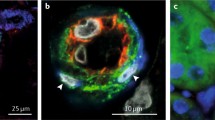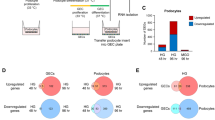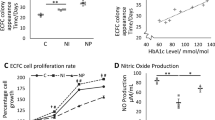Abstract
In some capillary beds, pericytes regulate endothelial growth. Capillaries with high filtration capacity, such as those in renal glomeruli, lack pericytes. Glomerular endothelium lies adjacent to visceral epithelial cells (podocytes) that are anchored to and cover the anti-luminal surface of the basement membrane. We have tested the hypothesis that podocytes can function as endothelial supporting cells. Endothelial cells were outgrown from circulating endothelial progenitors of normal subjects and were extensively characterized. These blood outgrowth endothelial cells (BOECs) expressed endothelial markers, lacked stem cell markers, and expressed the angiopoietin-1 receptor, Tie-2, and the vascular endothelial growth factor (VEGF) receptor, Flk-1. Differentiated podocytes in culture expressed and secreted VEGF, which was upregulated 4.5-fold by high glucose. In complete medium, BOECs formed thin cell-cell connections and multicellular tubes on Matrigel, the in vitro correlate of angiogenesis. This was impaired in deficient media but rescued by co-incubation with Transwell Anopore inserts containing differentiated podocytes. To assess whether VEGF was the major podocyte-derived signal that rescued BOEC angiogenesis, we examined angiogenesis of control and Flk-1-deficient BOECs. Co-incubation with podocytes or addition of recombinant VEGF each rescued angiogenesis in control BOECs, but both failed to support maintenance and angiogenesis in Flk-1-deficient BOECs. Finally, co-culture with podocytes increased BOEC-proliferation. In concert, these findings suggest a model in which glomerular visceral epithelial cells function as pericyte-like endothelial supporting cells. Podocyte-derived VEGF is a required and sufficient regulator of vascular endothelial maintenance, and its upregulation in podocytes by high glucose may be the mechanism for the increased glomerular angiogenesis that is observed in vivo in early diabetic glomerular injury.




Similar content being viewed by others
References
Cogan DG, Toussaint D, Kuwabara T (1961) Retinal vascular patterns. IV. Diabetic retinopathy. Arch Ophthalmol 66:366–378
Darland DC, Massingham LJ, Smith SR, Piek E, Saint-Geniez M, D’Amore PA (2003) Pericyte production of cell-associated VEGF is differentiation-dependent and is associated with endothelial survival. Dev Biol 264:275–288
Edwards MS, Wilson DB, Craven TE, Stafford J, Fried LF, Wong TY, Klein R, Burke GL, Hansen KJ (2005) Associations between retinal microvascular abnormalities and declining renal function in the elderly population: the Cardiovascular Health Study. Am J Kidney Dis 46:214–224
Engerman RL (1989) Pathogenesis of diabetic retinopathy. Diabetes 38:1203–1206
Fan L, Wakayama T, Yokoyama S, Amano O, Iseki S (2002) Downregulation of vascular endothelial growth factor and its receptors in the kidney in rats with puromycin aminonucleoside nephrosis. Nephron 90:95–102
Feng D, Nagy JA, Brekken RA, Pettersson A, Manseau EJ, Pyne K, Mulligan R, Thorpe PE, Dvorak HF, Dvorak AM (2000)Ultrastructural localization of the vascular permeability factor/vascular endothelial growth factor (VPF/VEGF) receptor-2 (FLK-1, KDR) in normal mouse kidney and in the hyperpermeable vessels induced by VPF/VEGF-expressing tumors and adenoviral vectors. J Histochem Cytochem 48:545–556
Gerhardt H, Wolburg H, Redies C (2000) N-cadherin mediates pericytic-endothelial interaction during brain angiogenesis in the chicken. Dev Dyn 218:472–479
Hohenstein B, Hausknecht B, Boehmer K, Riess R, Brekken RA, Hugo CP (2006) Local VEGF activity but not VEGF expression is tightly regulated during diabetic nephropathy in man. Kidney Int 69:1654–1661
Hoshi S, Nomoto K, Kuromitsu J, Tomari S, Nagata M (2002) High glucose induced VEGF expression via PKC and ERK in glomerular podocytes. Biochem Biophys Res Commun 290:177–184
Ichinose K, Maeshima Y, Yamamoto Y, Kitayama H, Takazawa Y, Hirokoshi K, Sugiyama H, Yamasaki Y, Eguchi K, Makino H (2005) Antiangiogenic endostatin peptide ameliorates renal alterations in the early stage of a type 1 diabetic nephropathy model. Diabetes 54:2891–2903
Iglesias-de la Cruz MC, Ziyadeh FN, Isono M, Kouahou M, Han DC, Kalluri R, Mundel P, Chen S (2002) Effects of high glucose and TGF-beta1 on the expression of collagen IV and vascular endothelial growth factor in mouse podocytes. Kidney Int 62:901–913
Kawamura H, Kobayashi M, Li Q, Yamanishi S, Katsumura K, Minami M, Wu DM, Puro DG (2004) Effects of angiotensin II on the pericyte-containing microvasculature of the rat retina. J Physiol (Lond) 561:671–683
Levidiotis V, Power DA (2005) New insights into the molecular biology of the glomerular filtration barrier and associated disease. Nephrology (Carlton) 10:157–166
Lin Y, Weisdorf DJ, Solovey A, Hebbel RP (2000) Origins of circulating endothelial cells and endothelial outgrowth from blood. J Clin Invest 105:71–77
Manaviat MR, Afkhami M, Shoja MR (2004) Retinopathy and microalbuminuria in type II diabetic patients. BMC Ophthalmol 4:9
Nyengaard JR, Rasch R (1993) The impact of experimental diabetes mellitus in rats on glomerular capillary number and sizes. Diabetologia 36:189–194
Oishi K, Kamiyashiki T, Ito Y (2007) Isometric contraction of microvascular pericytes from mouse brain parenchyma. Microvasc Res 73:20–28
Satchell SC, Harper SJ, Tooke JE, Kerjaschki D, Saleem MA, Mathieson PW (2002) Human podocytes express angiopoietin 1, a potential regulator of glomerular vascular endothelial growth factor. J Am Soc Nephrol 13:544–550
Schiwek D, Endlich N, Holzman L, Holthofer H, Kriz W, Endlich K (2004) Stable expression of nephrin and localization to cell-cell contacts in novel murine podocyte cell lines. Kidney Int 66:91–101
Shepro D, Morel NM (1993) Pericyte physiology. FASEB J 7:1031–1038
Simon M, Rockl W, Hornig C, Grone EF, Theis H, Weich HA, Fuchs E, Yayon A, Grone HJ (1998) Receptors of vascular endothelial growth factor/vascular permeability factor (VEGF/VPF) in fetal and adult human kidney: localization and [125I]VEGF binding sites. J Am Soc Nephrol 9:1032–1044
Singh SK, Behre A, Singh MK (2001) Diabetic retinopathy and microalbuminuria in lean type 2 diabetes mellitus. J Assoc Physicians India 49:439–441
Wang S, Caestecker M de, Kopp J, Mitu G, Lapage J, Hirschberg R (2006) Renal bone morphogenetic protein-7 protects against diabetic nephropathy. J Am Soc Nephrol 17:2504–2512
White KE, Bilous RW (2004) Structural alterations to the podocyte are related to proteinuria in type 2 diabetic patients. Nephrol Dial Transplant 19:1437–1440
Wong TY, Coresh J, Klein R, Muntner P, Couper DJ, Sharrett AR, Klein BE, Heiss G, Hubbard LD, Duncan BB (2004) Retinal microvascular abnormalities and renal dysfunction: The Atherosclerosis Risk in Communities Study. J Am Soc Nephrol 15:2469–2476
Yamamoto Y, Maeshima Y, Kitayama H, Kitamura S, Takazawa Y, Sugiyama H, Yamasaki Y, Makino H (2004) Tumstatin peptide, an inhibitor of angiogenesis, prevents glomerular hypertrophy in the early stage of diabetic nephropathy. Diabetes 53:1831–1840
Author information
Authors and Affiliations
Corresponding author
Additional information
These studies were supported by grants from the National Institutes of Health (NIH-NIDDK 63360) and the Juvenile Diabetes Research Foundation (JDRF-1-2004-78).
Rights and permissions
About this article
Cite this article
Hirschberg, R., Wang, S. & Mitu, G.M. Functional symbiosis between endothelium and epithelial cells in glomeruli. Cell Tissue Res 331, 485–493 (2008). https://doi.org/10.1007/s00441-007-0526-z
Received:
Accepted:
Published:
Issue Date:
DOI: https://doi.org/10.1007/s00441-007-0526-z




